Ditapis dengan
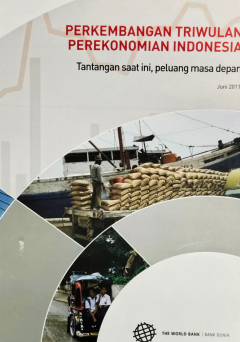
Perkembangan Triwulanan Perekonomian Indonesia ; Tantangan Saat Ini, Peluang …
Laporan Juni 2011 ini memuat perkembangan terkini dan prediksi ke depan ekonomi Indonesia seperti: Kinerja ekonomi Indonesia tetap positif dengan potensi yang lebih baik lagi di masa depan, walaupun demikian, perkembangan terakhir menunjukkan tantangan dan risiko tetap ada. Ekonomi meningkat pada level sedang pada Q1 2011, tapi masih menunjukan pertumbuhan pertumbuhan tahun-ke-tahunnya 6,5 persen.
- Edisi
- 1
- ISBN/ISSN
- -
- Deskripsi Fisik
- 48 halaman
- Judul Seri
- Textbook
- No. Panggil
- 330.05 THE p
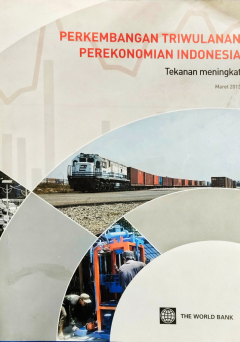
Perkembangan Triwulanan Perekonomian Indonesia ; Tekanan meningkat Maret 2013
Buku "Perkembangan Triwulanan Perekonomian Indonesia: Tekanan Meningkat Maret 2013" menyajikan analisis mendalam mengenai kondisi perekonomian Indonesia pada triwulan pertama tahun 2013. Buku ini memberikan gambaran komprehensif tentang berbagai faktor yang mempengaruhi perekonomian nasional, serta tantangan yang dihadapi selama periode tersebut.
- Edisi
- Maret 2013
- ISBN/ISSN
- -
- Deskripsi Fisik
- 55 halaman
- Judul Seri
- Textbook
- No. Panggil
- 330.05 THE p

Protecting Poor and Vulnerable Households in Indonesia
Despite strong economic growth and falling poverty over the last decade, many households continue to live on the edge of poverty. The last decade in Indonesia has seen a return to strong economic growth, and the poverty rate has fallen from 23.4 percent (1999) to 12.5 percent (2011). The falling overall poverty rate, however, partially masks a high degree of vulnerability: much of Indonesia's p…
- Edisi
- 1
- ISBN/ISSN
- -
- Deskripsi Fisik
- 106 halaman
- Judul Seri
- Textbook
- No. Panggil
- 362.5 THE p
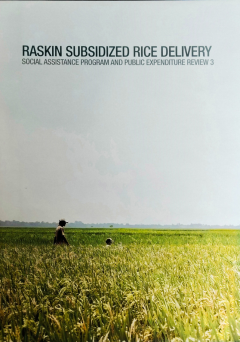
Raskin Subsidized Rice Delivery : Social Assistance Program and Public Expend…
The Beras untuk Rakyat Miskin (Raskin) program was introduced as an emergency food security program in 1998; it delivers rice to be purchased at subsidized prices, prioritized to poor and near-poor households. In terms of government expenditure, Raskin remains the largest permanent social assistance transfer targeted to poor households in Indonesia.
- Edisi
- 1
- ISBN/ISSN
- -
- Deskripsi Fisik
- 28 halaman
- Judul Seri
- Textbook
- No. Panggil
- 330.05 THE r

RESILIENCE ; How Six Decades of Partnership Helped Transform Indonesia and Th…
Indonesia is emerging to take its place in the world as a rising middle-income country, confident in its destiny. The road to increasing prosperity and democracy has been as remarkable as it has been difficult. Throughout major social and political upheavals Indonesia has remained resilient.
- Edisi
- 1
- ISBN/ISSN
- -
- Deskripsi Fisik
- 30 cm
- Judul Seri
- Textbook
- No. Panggil
- 332.1532 THE r
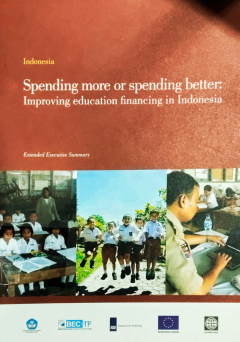
Spending more or spending better: Improving education financing in Indonesia …
The report is divided into two parts. The first three chapters show that the vast increase in education resources has not been accompanied by a similar increase in learning outcomes, and thus highlight the urgent need to improve the quality of spending. Chapter one starts by describing the complex financing and governance systems.
- Edisi
- 1
- ISBN/ISSN
- -
- Deskripsi Fisik
- 40 halaman
- Judul Seri
- Textbook
- No. Panggil
- 353.5 THE s

Spending more or spending better: Improving education financing in Indonesia …
The report is divided into two parts. The first three chapters show that the vast increase in education resources has not been accompanied by a similar increase in learning outcomes, and thus highlight the urgent need to improve the quality of spending. Chapter one starts by describing the complex financing and governance systems.
- Edisi
- 1
- ISBN/ISSN
- -
- Deskripsi Fisik
- 114 halaman
- Judul Seri
- Textbook
- No. Panggil
- 353.5 THE s
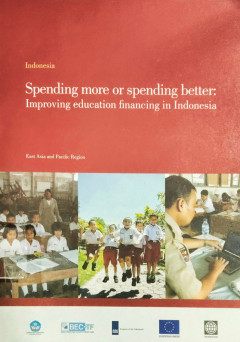
Spending more or spending better: Improving education financing in Indonesia
The report is divided into two parts. The first three chapters show that the vast increase in education resources has not been accompanied by a similar increase in learning outcomes, and thus highlight the urgent need to improve the quality of spending. Chapter one starts by describing the complex financing and governance systems.
- Edisi
- 1
- ISBN/ISSN
- -
- Deskripsi Fisik
- 114 halaman
- Judul Seri
- Textbook
- No. Panggil
- 353.5 THE s
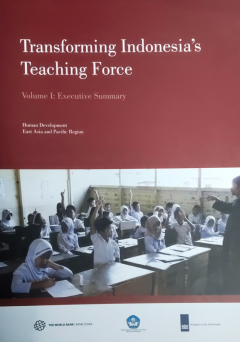
Transforming Indonesia's Teaching Force ; Volume I : Executive Summary
The report on the transforming Indonesia's teaching force is divided in two volumes. The executive summary is the first volume of a two-volume comprehensive report on teacher management in Indonesia. This volume summarizes the key findings of the detailed technical analysis in volume two, but with much greater focus on the key areas where policy reforms will likely generate a large impact in In…
- Edisi
- 1
- ISBN/ISSN
- -
- Deskripsi Fisik
- 26 halaman
- Judul Seri
- Textbook
- No. Panggil
- 353.5 THE t
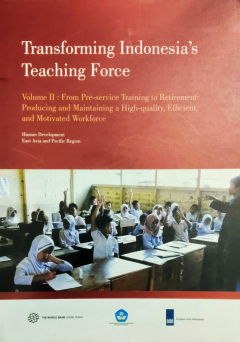
Transforming Indonesia's Teaching Force ; Volume II
The report on the transforming Indonesia's teaching force is divided in two volumes. The executive summary is the first volume of a two-volume comprehensive report on teacher management in Indonesia. This volume summarizes the key findings of the detailed technical analysis in volume two, but with much greater focus on the key areas where policy reforms will likely generate a large impact in In…
- Edisi
- 1
- ISBN/ISSN
- -
- Deskripsi Fisik
- 103 halaman
- Judul Seri
- Textbook
- No. Panggil
- 353.5 THE t
 Karya Umum
Karya Umum  Filsafat
Filsafat  Agama
Agama  Ilmu-ilmu Sosial
Ilmu-ilmu Sosial  Bahasa
Bahasa  Ilmu-ilmu Murni
Ilmu-ilmu Murni  Ilmu-ilmu Terapan
Ilmu-ilmu Terapan  Kesenian, Hiburan, dan Olahraga
Kesenian, Hiburan, dan Olahraga  Kesusastraan
Kesusastraan  Geografi dan Sejarah
Geografi dan Sejarah